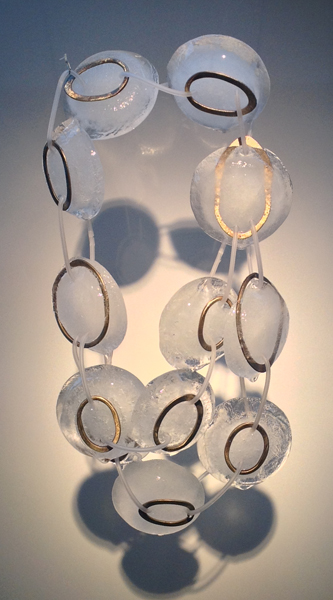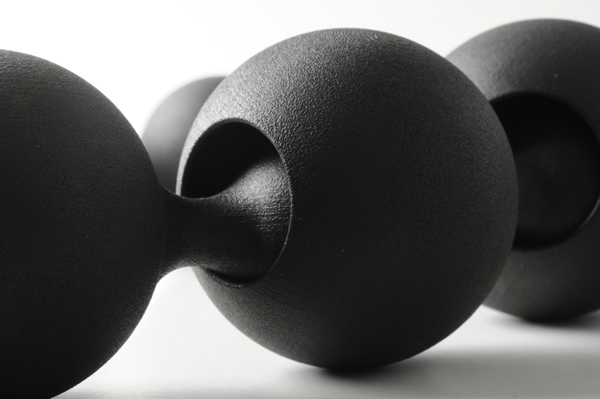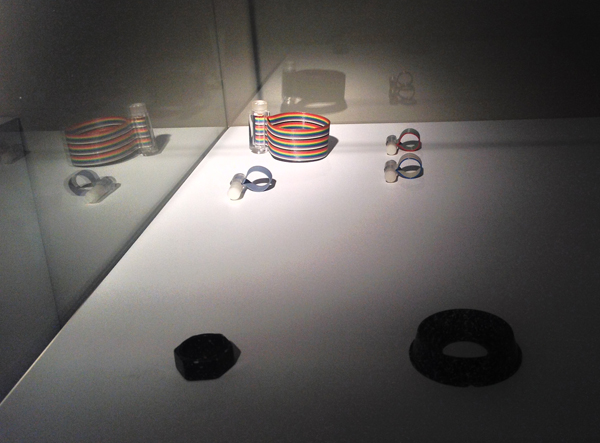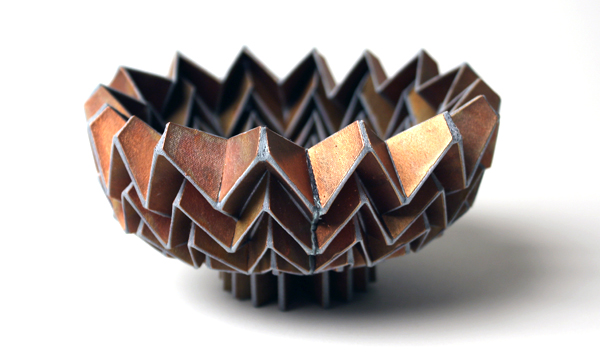
Susan Cummins: How does TWEEX 2 expand on the theme of the transmission of knowledge from the teacher to the student in the jewelry programs in Belgium, which you began with TWEEX 1?
Françoise Vanderauwera: Using the theme of transmission, the whole TWEEX project contributes to a better understanding of the origin and the evolution of Belgian contemporary jewelry.
TWEEX 2 is the continuation of TWEEX 1 and features creations by masters and students from three other major schools in Belgium: The Institut de la Parure & de la Bijouterie Jeanne Toussaint/Arts & Métiers, (Brussels); MAD-Faculty Object & Jewellery (Hasselt); and The Académie des Beaux-Arts of the City of Arlon.
TWEEX 2 also pays homage to Emile Souply, a well-known Belgian sculptor and contemporary jewelry teacher at Arts et Métiers, Brussels, who passed away this year.
The generational aspect was clearly underlined during this exhibition.
What is the benefit to the gallery of doing a series of related shows?
Françoise Vanderauwera: Thanks to the collaboration of Bernard François, curator, and Anne Hustache, art historian, the benefit to the gallery is the public attractiveness of this kind of museum-like event, which gives it greater visibility and brings it a lot of credit. A series of related shows underlined the exceptional character and the serious, deep approach of this type of initiative.

Can you describe the differences you see between the works coming out of these schools?
Françoise Vanderauwera: Work coming out of higher education institutions with bachelor- and master-degree programs has, in my view, a faster chance (but not always) of being a good piece. By “a good piece,” I mean one with the right balance of contemporary expression, know-how, and innovation.
This difference between masters students and those from art academies or vocational colleges is essentially a difference in the “speed of reaction” rather than in the quality, and it ends as soon as the student acquires greater experience and is able to learn by him or herself.
It is also true that a work from a student with a strong artistic background might be less spontaneous and be less of a pure creation that is “beautiful in essence.”
This is why the teacher, the transmitter, is very important and has a threefold task: delivering minds and sharing passions (as in TWEEX 1); enabling inherent creativity to take place; and imparting the basics in the meantime. This is a particular mix that has to be evaluated case by case, depending on the creator, the teacher, and finally, the school.

Innovation is everywhere (it is part and parcel of research, and it extends beyond the frontiers of shapes, materials, values, and meaning), but some work from well-equipped schools is technologically advanced compared to some from the less-equipped schools.
Also, some schools are oriented toward both objects and jewelry, while others are jewelry-only. But, they are always body-oriented to a large extent.
I think the schools that call themselves into question and that transmit knowledge that can help meet the students’ various requirements while also providing them with the basics will stay on top.
But, that remains to be seen the next time we take stock.

Françoise Vanderauwera: To name but a few during TWEEX 2:
Lucia Bacchiocchi from Brussels, with her ephemeral jewel made of ice, nickel silver, and rubber, won unanimous acclaim. This piece, which is not novel in itself—Dinie Besems (Netherlands) made a similar piece in the 1990s)—catches everybody’s eye due to its poetic, contemplative mood and its link to a current concern (the preciousness of water, which is the new blue gold).
X-large Flatbeads by Lore Langendries (Hasselt) attracted a lot of interest for her technical and visual language (laser-cut flat beads and the volume lent by the use of animal hair).
The new, incredible-but-so-true stories told by Delphine Joly (Brussels), which are always significant and are of particular interest for the use of leather.
Also, Monique Voz (Arlon), whose clinically minded installation made of skin footprints on silicon stimulates the viewers’ participation and really makes them think about their skin, DNA, and footprints.
Do you know Jesus? is the work of Nathalie Desmedt (Arlon). Radical and well executed, it is a remarkable work in resin, a material that featured particularly strongly in the propositions from Arlon.
And, I must say that Claudia Hoppe’s (Hasselt) fine bracelets were also highly appreciated for their very simple appearance but high level of skills and know-how.

Françoise Vanderauwera: Emile Souply’s colorful bracelet and rings made of side-by-side cable and Plexiglas. They were made around the 1970s, yet they are still so contemporary.
Karen Wuytens’s gorgeous girls with a pearl necklace—our headliner—is a perfect testimony to high technology combined with the full control of artistic perspective. It is a successful example of transmission, following in the footsteps of the splendid work of David Huycke, continuing and rethinking granulation.
Tine De Ruysser’s bowl wave I is an amazingly flexible combination of metal and textile! A must-see and must-touch.
Plica ex-plica, a 1997 sculptural silver necklace by Thierry Bontridder, which found a purchaser during TWEEX 2.
Do you have plans for TWEEX 3? What can we expect to see then?
Françoise Vanderauwera: TWEEX 3 will show the work of the four remaining schools that are of significance for contemporary jewelry in Belgium: RHoK Brussels, KASK Antwerpen, Académie de Châtelet, and SASK Sint Niklaas. Again, it will be a subtle mix of masters and emerging artists with different background levels of knowledge.
A final show will provide more reading keys for novices and more surprises for aficionados. All in all, the whole TWEEX project will hopefully ensure that Belgian contemporary jewelry takes its rightful place in the international scene.

Françoise Vanderauwera: People may order the catalog and keep in touch with our previous, current, and forthcoming activities on our website.
For the time being, the catalog is also available at:
WCC-BF, Mons
Grand Hornu Images, Mons
Le Centre Wallonie-Bruxelles à Paris
Thank you.





